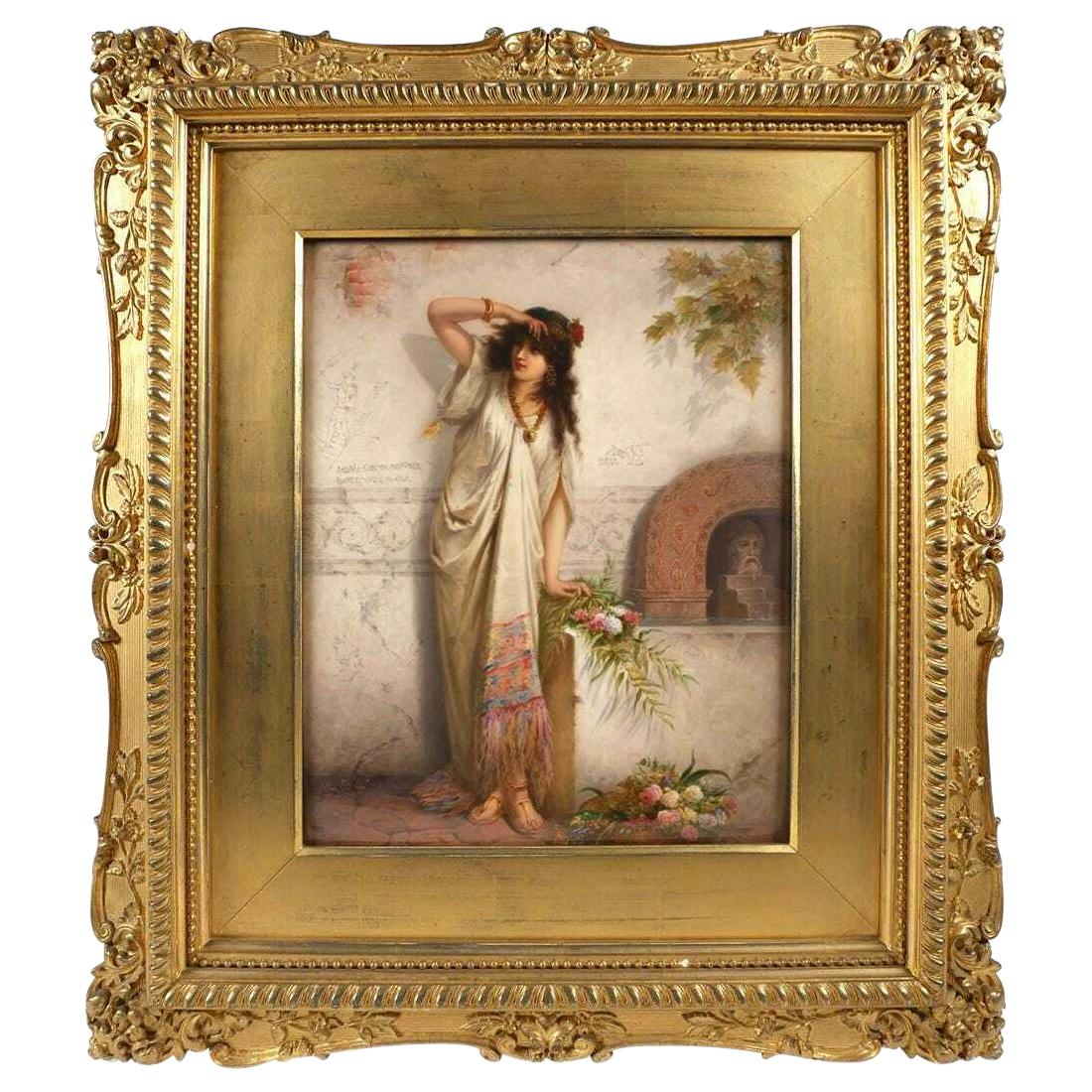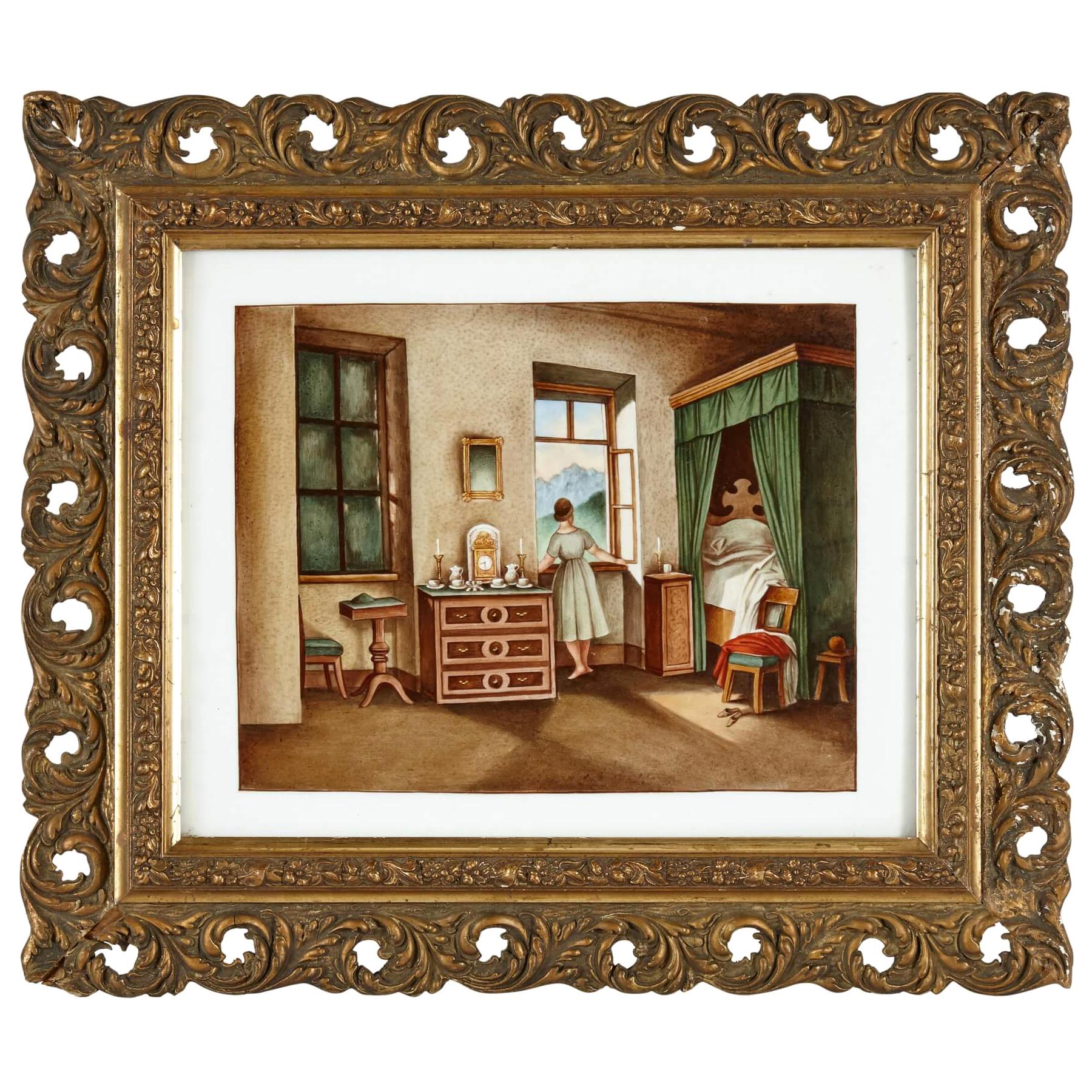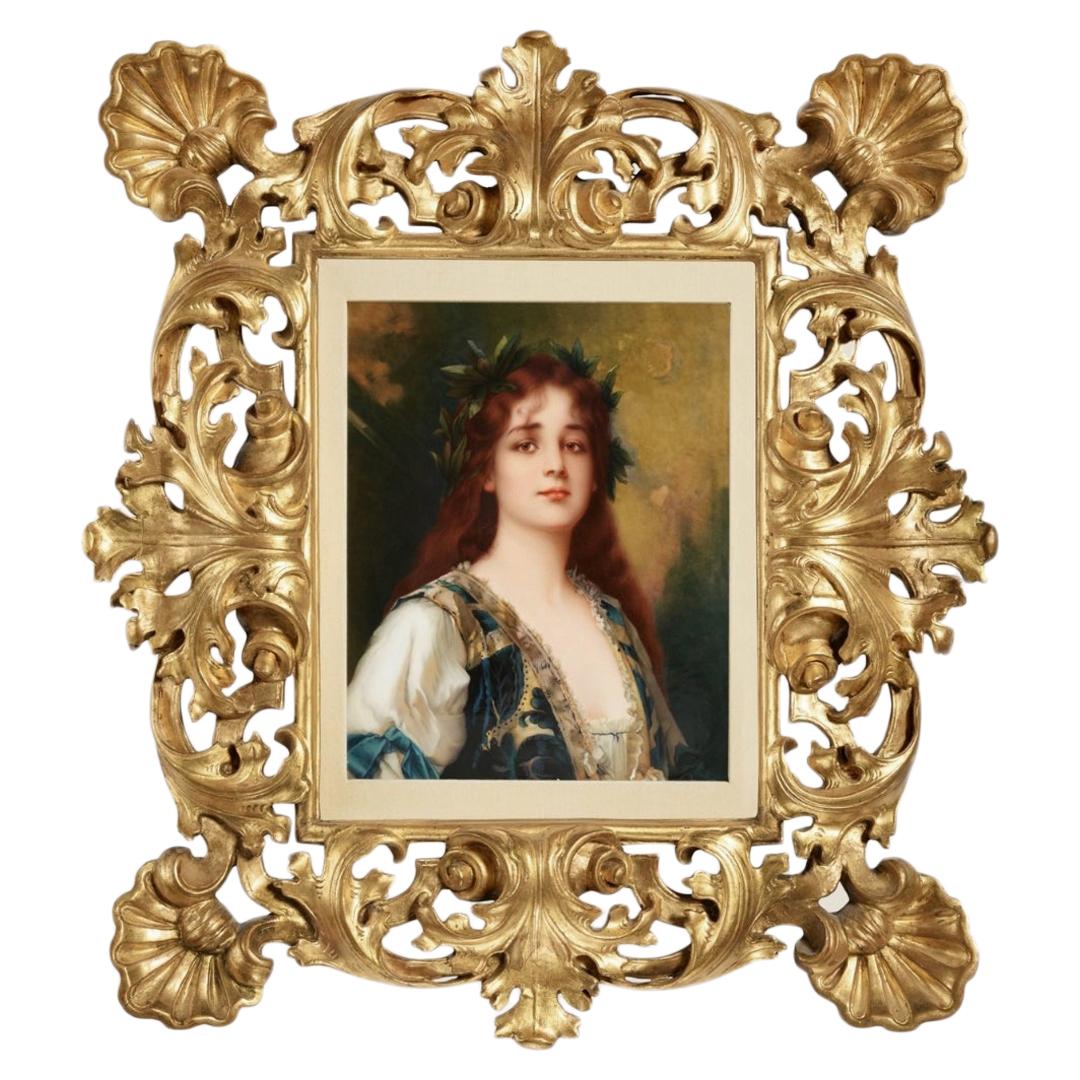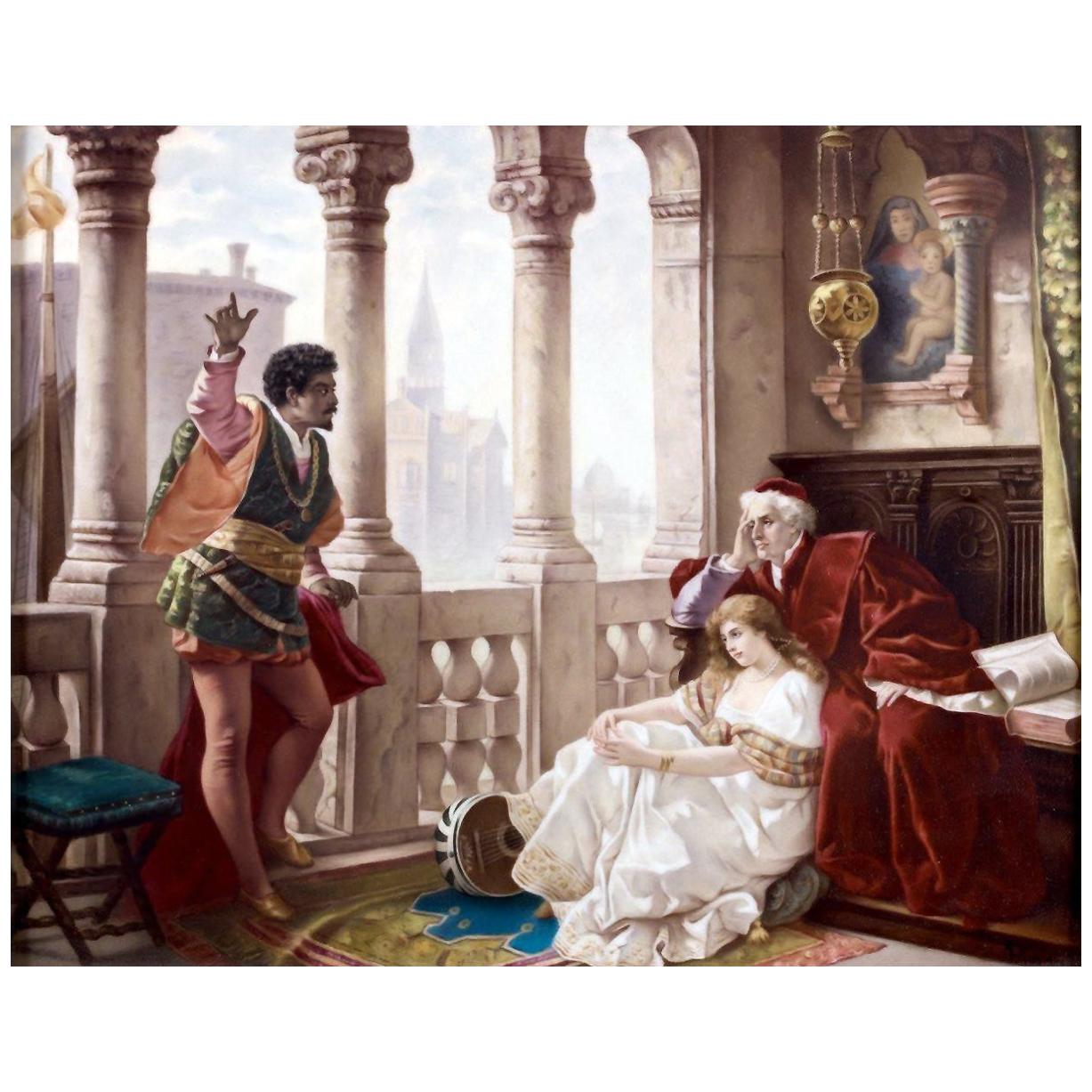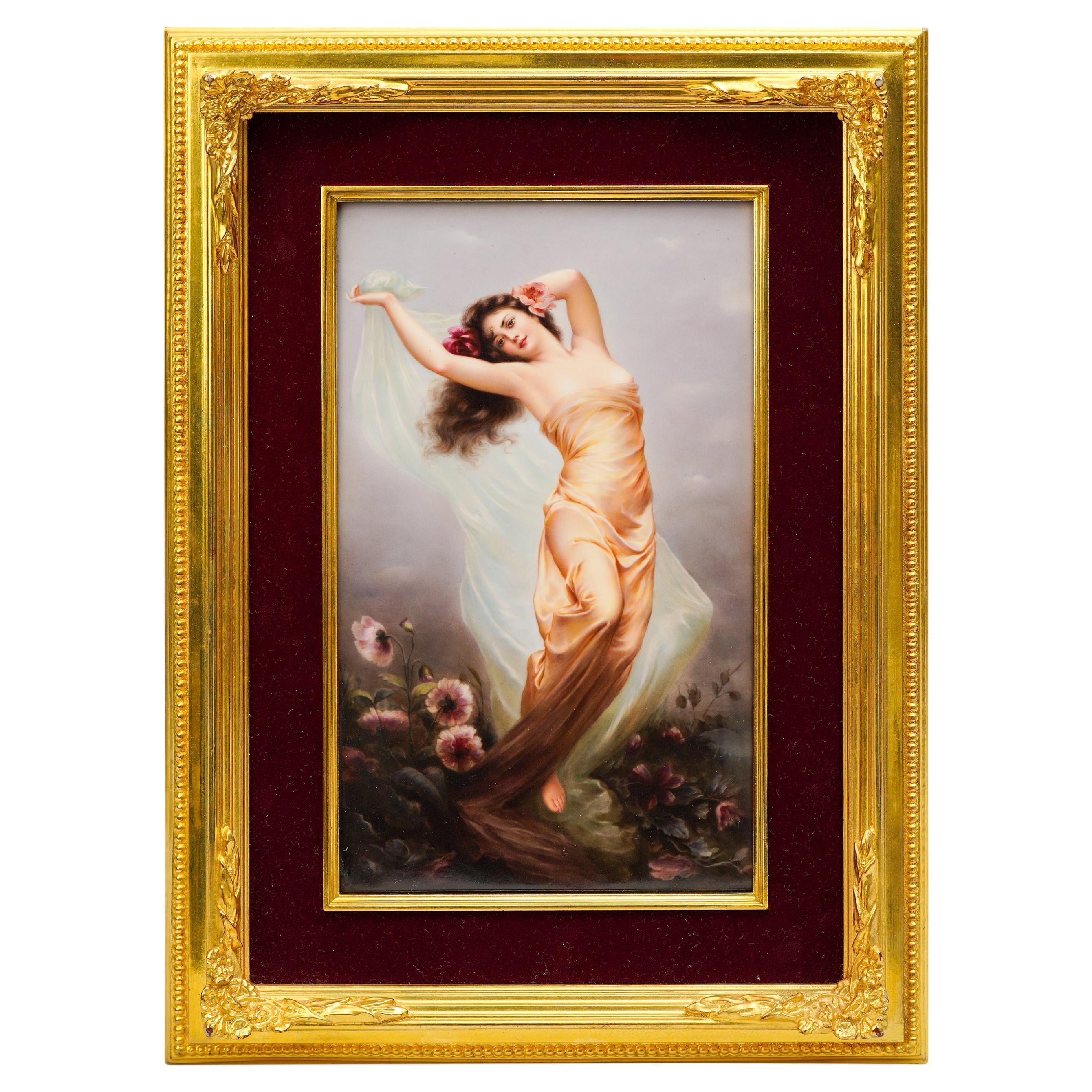Items Similar to German Romantic KPM La Gondole D’amour Porcelain Plaque
Want more images or videos?
Request additional images or videos from the seller
1 of 11
German Romantic KPM La Gondole D’amour Porcelain Plaque
About the Item
La Gondole D’amour (The Gondola of Love)
From our Cermics collection, we are delighted to offer this KPM La Gondole D’amour Porcelain Plaque. The plaque of rectangular form with a gilt beaded frame and coral mount depicting La Gondole D’amour. La Gondole D’amour translates to The Gondola of Love and was originally painted by the Italian artist Ignace Spiridon (1848–1930), it shows a gondola in the middle of a river with a cupid like cherub at the helm and two lovers laying to the rear of the gondola. The rear of the plaque has been left open to view the incised sceptre KPM mark, number 255195 and two further manufacturing marks. The plaque dates to the late 19th century Circa 1870.
KPM (Königliche Porzellan-Manufaktur – The Royal Porcelain Factory) in Berlin was founded in 1763 Frederick the Great (King Frederick II). Its actual origins, however, lie in three private enterprises which, under crown patronage, were trying to establish the production of “white gold” (porcelain) in Berlin from the mid-18th century onwards.The company logo is a sceptre, which is stamped (painted prior to 1837) or incised on every piece. All painted pieces produced by KPM are also signed by the painter. KPM is still producing porcelain today.
Measurements (centimetres) Frame 41cm Wide x 34.5cm High, Plaque Approximately 20.5cm Wide x 18cm High
- Creator:
- Dimensions:Height: 13.58 in (34.5 cm)Width: 16.14 in (41 cm)Depth: 0.5 in (1.27 cm)
- Style:Baroque Revival (Of the Period)
- Materials and Techniques:
- Place of Origin:
- Period:
- Date of Manufacture:Circa 1870
- Condition:Wear consistent with age and use.
- Seller Location:Newark, GB
- Reference Number:
About the Seller
5.0
Vetted Seller
These experienced sellers undergo a comprehensive evaluation by our team of in-house experts.
Established in 2019
1stDibs seller since 2022
18 sales on 1stDibs
Typical response time: 3 hours
- ShippingRetrieving quote...Ships From: Newark, United Kingdom
- Return PolicyA return for this item may be initiated within 14 days of delivery.
More From This SellerView All
- French 'Sevres' Porcelain BoxBy Manufacture Nationale de SèvresLocated in Newark, EnglandA large sized ‘Sevres‘ porcelain box. The box decorated with a base of cobalt blue with gild scrollwork decoration throughout. The lid featuring a large painted panel with a classica...Category
Antique Early 1900s French Napoleon III Ceramics
MaterialsCeramic, Porcelain
- Vienna Porcelain Classical VaseBy Royal Vienna PorcelainLocated in Newark, EnglandFine ‘Vienna‘ Austria porcelain vase. The vase of Classic Roman shape with flared rim and pinched neck with scrolling shoulders and tapered body stood...Category
Antique Late 19th Century Austrian Classical Roman Vases
MaterialsCeramic, Porcelain
- German Memento Mori Carved SkullLocated in Newark, EnglandAntique 18th century fruitwood carved Memento Mori Skull. The skull of petrified display powerfully carved in the form of a human skull consisting of the cranium, upper and lower jaws, the cadaverous face with deliberate missing tooth in brown wash patination throughout. Stood upon a small marble base with the skull attaching via a dowel fitting. The Skull probably from German origin. Notes From approximately the sixteenth century, skulls were commonly used to remember death as they symbolise the transience of human life. Memento Mori literal Latin translation means remember that you [have to] die. The concept has its roots in the philosophers of classical antiquity, and appeared in funeral art and architecture of the medieval period. Memento Mori jewellery...Category
Antique 18th Century German Gothic Mounted Objects
MaterialsMarble
- German Oversized Memento Mori Glass FluteLocated in Newark, EnglandUnusual 1920's German oversized glass flute. The flute with circular base and tapered body with gilt rim opening and stylised bubble decoration within the stem. To each side etched decoration with a Memento mori to one side and an insignia reading SUUM CUIQUE to the other representing the Order of the Black Eagle. Notes suum cuique, Latin translated as "to each his own" or "may all get their due". It has been significant in the history of philosophy and as a motto. The Order of the Black Eagle as seen on the glass is the current emblem for the German Military Police. Originally the Order of the Black Eagle was the highest order of chivalry in the Kingdom of Prussia. The order was founded on 17 January 1701 by Elector Friedrich III of Brandenburg (Friedrich I King of Prussia). In his Dutch exile after World War I, deposed Emperor Wilhelm...Category
Vintage 1920s German Glass
MaterialsGlass
- German Silver Gilt Minaudière Louis KuppenheimBy Louis KuppenheimLocated in Newark, EnglandThe minaudière of rectangular form with curved corners features a repousse monkey which humorously goes through the case with the front side of the monkey on the cover and the rear side of the monkey on the back. The exterior of the case is gilded Silver with cabochon Sapphires and a top carry loop. To the left of the top a second loop contains the original pencil which pulls out for taking notes upon the ivorine notepad within. The interior of the case features several compartments which open via the Sapphire tabs, the left side contains two smaller compartments while the right side features a bevel edged mirror with an ivorine notepad to the reverse and a spring loaded tab to the compartment. The case is hallmarked in several locations with the London ‘omega’ import mark (1906-1998), the import Silversmiths mark Gresham Barber & Co and is dated 1907. Although the minaudière does not bear the original makers hallmark we firmly attribute the case to Louis Kuppenheim a renowned German Silversmith who made designs matching this minaudière. Louis Kuppenheim (1824-1889)was founded in 1854 together with Heinrich Witzemann they were located in Pforzheim, southwestern Germany and is known as the gateway to the Black Forest. In 1857 Kuppenheim moved forward as a solo business without his partner and moved to Durlacher Straße 1, Old Town street in Pforzheim. Upon the death of Louis Kuppenheim in 1889 3 of his 6 children (Albert, Hugo and Moritz) took over running the company and in 1900 at the Universal Exhibition in Paris the firm won a gold medal for a paper knife. In the same year the company opened the first store in the Rue de Richelieu 67 in Paris. In the 1900s Hans Christiansen designed some silver parts and pieces of jewellery, which were made by the Manufacture Kuppenheim. Christiansen was an important Art Nouveau painter and a member of the Darmstadt artists’ colony. In 1906 Albert, Hugo and Moritz convert the inherited jewellery factory into a modern gold and silverware fabrication and one year later relocated to 69 Durocher Street. Over the next 30 years the company expanded their business with mechanical workshops for gold and silver along with more machinery along with the death of Albert Kuppenheim and Ludwig (another son of Louis) taking over the company. After the war broke out in 1939 the company went into liquidation ending its 82 year history. During the heyday of the company over 200 people were employed by Louis Kuppenheim making it one of the most important employers in the jewellery city of Pforzheim. In the more than eighty years of production some 100,000 pieces left the company. Kuppenheim made many items in small series, for example boxes and minaudières (women’s fashion accessory, generally considered a jewellery piece, intended to substitute for an evening bag. A case with compartments, it allows storage for several items in a small space, such as a makeup compact, lipstick, watch, reading glasses, or keys) and compacts and cigarette cases...Category
Antique Early 1900s German Art Nouveau Sterling Silver
MaterialsGold Plate, Silver
- Amphora Art Deco Elephant & Lion Porcelain Group, CzechoslovakiaBy AmphoraLocated in Newark, EnglandLarge Amphora porcelain figural group featuring two lionesses attacking an elephant. The figure of extraordinary size measuring 66.5cm High (26.18inches) featuring a large elephant s...Category
Early 20th Century Czech Art Deco Animal Sculptures
MaterialsCeramic, Porcelain
You May Also Like
- German KPM Porcelain Portrait PlaqueBy Königliche Porzellan-Manufaktur (KPM)Located in New York, NYSigned rectangular hand painted portrait on porcelain, showing a woman with flowers, with KPM mark verso. Maker: K.P.M. Origin: ...Category
Antique 19th Century German Decorative Art
MaterialsPorcelain
- German KPM Porcelain Plaque of an Interior Bedroom SceneBy Königliche Porzellan-Manufaktur (KPM)Located in London, GBGerman KPM porcelain plaque of an interior bedroom scene German, late 19th century Dimensions: Frame height 38cm, width 44cm, plaque height 26.5cm, width 31cm This fine porcelai...Category
Antique Late 19th Century Rococo Decorative Art
MaterialsGiltwood, Porcelain
- 'Clementine', a Large Berlin 'KPM' Porcelain PlaqueBy Königliche Porzellan-Manufaktur (KPM)Located in Brighton, West Sussex'Clementine', A Large Berlin (KPM) Porcelain Plaque After Conrad Kiesel. In a fine pierced giltwood and composition frame. Inscribed 'nach C. Kiesel'...Category
Antique 19th Century German Decorative Art
MaterialsGiltwood, Porcelain
- KPM Porcelain Plaque Depicting a Scene from OthelloBy Königliche Porzellan-Manufaktur (KPM)Located in Brighton, West SussexA fine KPM porcelain plaque depicting a scene from Shakespeare's Play Othello, after the painting by Carl Ludwig Friedrich Becker, (German, 1820-1900). Signed ‘R. Wagner’. Impressed mark to the reverse ‘KPM’ (Konigliche Porzellan...Category
Antique 19th Century German Decorative Art
MaterialsPorcelain, Giltwood
- KPM Porcelain Plaque of a Beautiful Floating LadyBy Königliche Porzellan-Manufaktur (KPM)Located in Los Angeles, CAA very fine German KPM porcelain plaque depicting a beauty floating ecstatically above a bed of flowers. Signed: Knys Impressed KPM and sceptre mark. Circa 1900 Dimensions: ...Category
Antique Late 19th Century German Paintings
MaterialsPorcelain
- Fine Berlin 'KPM' Porcelain Plaque of A Vestal VirginBy Königliche Porzellan-Manufaktur (KPM)Located in Brighton, West SussexA fine Berlin (K.P.M.) porcelain plaque of A Vestal Virgin, after Angelica Kauffman, in a giltwood frame. Impressed sceptre mark, 'KPM', letter 'H', ...Category
Antique 19th Century German Decorative Art
MaterialsPorcelain, Giltwood
